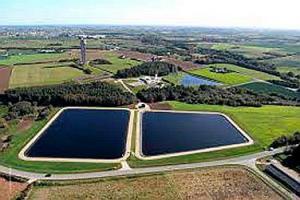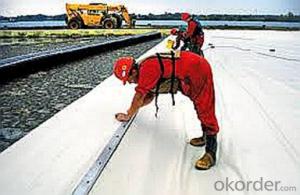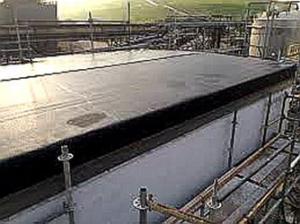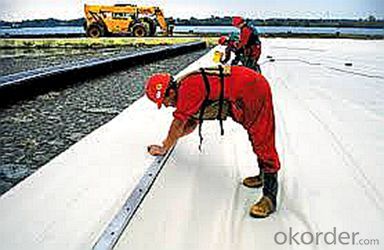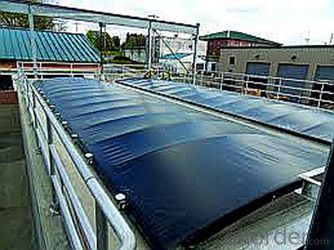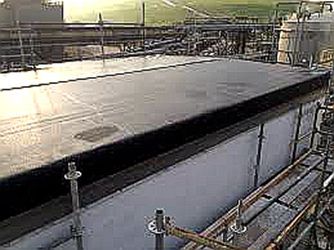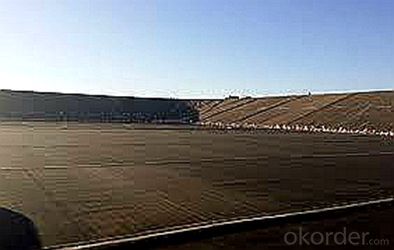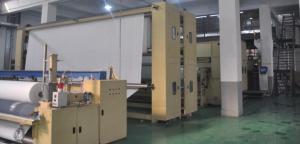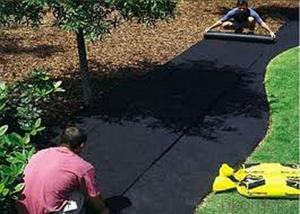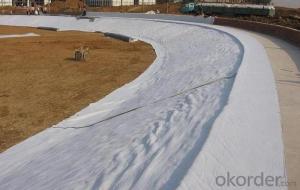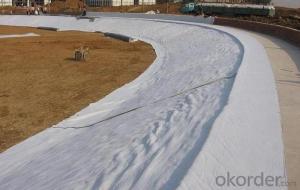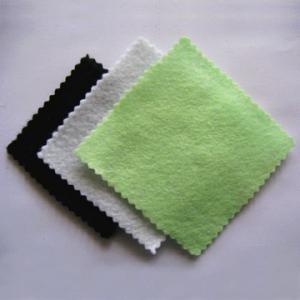Needle Punched Geotextile Fabric Waterproof Geomembrane for Decorative and Architectural Ponds
- Loading Port:
- China main port
- Payment Terms:
- TT OR LC
- Min Order Qty:
- 1000 m²
- Supply Capability:
- 1000000 m²/month
OKorder Service Pledge
OKorder Financial Service
You Might Also Like
Specification
Water Conservation Project Used Complex Geomembrane
1.pecifications
1) One layer geotextile and one layer membrane ; Weight of base geotextile : 100g/m2-1000gm2 ; Thickness of geomembrane :0.1mm-1.5mm .
2) Two layers geotextile and one layer membrane ; Weight of base geotextile : 80g/m2-600gm2 ; Thickness of geomembrane :0.2mm-1.5mm .
3) One layer geotextile and two layers membrane ; Weight of base geotextile : 100g/m2-1000gm2 ; Thickness of geomembrane :0.1mm-0.8mm .
4) Multi-layers : Weight of base geotextile : 100g/m2-1000gm2 ; Thickness of geomembrane :0.1mm-1.5mm .
2. Properties
Flexibility is good , except of a geotextile's isolation , drainage , reinforcement , protective functiona , it is also impermeable .
3. Usages
Widely used in dam , traffic tunnel , road, airport , drainage , housing , environmental protection.
Weight
400-1000g or As your request
Width
Within 4-6m as your request
Length
50m or As your request
Material
PET, PP and HDPE liner
Color
Black, White,or as your request
Type
Non-woven Short or Long Fiber and HDPE liner
Package
Double layers white woven geotextile or As your request
Shipping Marks
As your request or Neutral Packing
Production Standards GB, or As your request

Packaging & Shipping
Packing: PLASTIC FILM INSIDE, AND WOVEN BAG OUTSIDE
Shipping: About 15 days after receipt the deposit
geotextile fabric
permeability,filtration,easy for construction
ISO and CE certificate
Good quality and competitive price
Our Service
Quality assurance
1.On a regular basis or as per your request,we entrust national testing agencies to conduct quality inspections
2. Strictly in accordance with the ISO9001-2008 international quality system standard,we monitor and manage the whole process throughout production,quality testing,and measurement to ensure product quality
3. For quality-related construction delay or substandard construction(except for damage or losses due to customer’s responsibility or irresistible natural disasters),we have refunding,replacement,and repair services.We will respond to customers’ feedbacks on quality issues within 24 hours.
After-sales service
1.In order to provide customers with comprehensive technical support,we will provide technical and other related information upon request in a timely manner.
2.In required,we will appoint specialized technicians to the construction site to give technical trainings to construction people,and offer technical guidance throughout the whole construction process.
3.For damage due to shipment and delivery,after we receive the complaint,we will check the issure through provided pictures and videos.If our responsibility is confirmed,we wil offer free replacement.
4.When the construction is completed,as your request,our technical staff may participate in the final acceptance.
FAQ:
Q: What kind of payments does jenor support?
A: T/T, L/C, Cash are accepted.
Q: Do you charge for the samples?
A: Accordeing to our company policy, the samples are free, we only charge the freight fee. And we will return the freight fee during the next order.
Q: Can you produce according to customers' design?
A: Sure, we are professional manufacturer, OEM and ODM are both welcome.
Q: Do you have other products?
A: Yes, please check the pictures:
- Q: How do geotextiles contribute to sustainable construction practices?
- Geotextiles contribute to sustainable construction practices by providing a variety of environmental benefits. They help reduce soil erosion and sedimentation, improve water quality by filtering out pollutants, and enhance the stability and performance of infrastructure. Geotextiles also allow for the use of locally available materials, reducing transportation and carbon emissions. Overall, their use promotes the conservation of resources, minimizes environmental impacts, and supports long-term sustainability in construction projects.
- Q: What are the key differences between woven and nonwoven geotextiles?
- The key differences between woven and nonwoven geotextiles lie in their manufacturing processes and physical characteristics. Woven geotextiles are made by interlacing yarns or fibers together to create a stable and strong fabric. On the other hand, nonwoven geotextiles are produced by bonding or felting fibers together without any weaving process. In terms of physical characteristics, woven geotextiles generally have higher tensile strength and puncture resistance due to their interlaced structure. They also offer better filtration properties as the open spaces between the woven yarns allow for effective water flow. Nonwoven geotextiles, however, have a higher permittivity, meaning they have a greater ability to allow water to pass through. Another notable difference is their durability. Woven geotextiles tend to be more resistant to UV degradation and offer better long-term performance, making them suitable for applications that require high strength and stability over time. Nonwoven geotextiles, although less durable, are often used for short-term projects or where filtration and separation are the main requirements. Overall, the choice between woven and nonwoven geotextiles depends on the specific application and desired properties. Woven geotextiles are typically favored for their strength and longevity, while nonwoven geotextiles are preferred for their filtration capabilities and cost-effectiveness in certain applications.
- Q: Are geotextiles suitable for use in underground drainage systems?
- Yes, geotextiles are suitable for use in underground drainage systems. Geotextiles are permeable fabrics that can be used to separate, filter, reinforce, and drain soil in a drainage system. They help prevent the clogging of pipes and provide additional stability and longevity to the overall system.
- Q: What are the different geotextile installation techniques for landfill applications?
- There are several geotextile installation techniques commonly used for landfill applications. These include the direct burial method, where the geotextile is placed directly on the landfill surface and covered with soil or other materials; the geocomposite method, which involves placing a geotextile and a geomembrane together to create a composite liner; the anchor trench method, where the geotextile is anchored in a trench around the perimeter of the landfill; and the slope method, which involves installing the geotextile on the slope of the landfill to prevent erosion. Each technique has its advantages and is chosen based on the specific requirements and conditions of the landfill site.
- Q: What are the different factors to consider for geotextile selection in agricultural applications?
- Some of the different factors to consider for geotextile selection in agricultural applications include the required strength and durability of the geotextile, the type and weight of the soil, the presence of chemicals or contaminants, the desired permeability and drainage capacity, as well as the specific application and intended use of the geotextile. Additionally, factors such as installation requirements, cost-effectiveness, and environmental considerations should also be taken into account.
- Q: How do geotextiles help with load distribution in bridge approach fills?
- Geotextiles help with load distribution in bridge approach fills by acting as a separator and stress reliever. They prevent the mixing of different soil layers, reducing the potential for differential settlement and allowing for uniform load distribution. Additionally, geotextiles help to reinforce the soil, improving its overall strength and stability, which ultimately enhances the load-bearing capacity of the bridge approach fill.
- Q: Can geotextiles be used in pond liners?
- Yes, geotextiles can be used in pond liners. Geotextiles are often used as a protective layer in pond liners to provide additional strength, durability, and resistance to punctures or tears. They help prevent the migration of soil particles and provide stability to the liner, making them a suitable choice for pond construction.
- Q: How do geotextiles affect soil consolidation?
- Geotextiles can positively affect soil consolidation by improving the overall stability and load-bearing capacity of the soil. They can act as a separator, preventing the intermixing of different soil layers, which aids in achieving proper consolidation. Additionally, geotextiles can enhance drainage and prevent water buildup, reducing the risk of soil erosion and improving consolidation.
- Q: Geotextile how to sampling
- Related methods can refer to GB-1998, can also go to our factory to purchase, to observe. My contact is the name of the registration. Free testing training! All the country's site can be shipped!
- Q: How do geotextiles help with soil stabilization in foundation construction?
- Geotextiles help with soil stabilization in foundation construction by providing a barrier between the soil layers, preventing the mixing of different soil types. This separation helps in maintaining the integrity and strength of the foundation, as well as preventing the migration of fine particles that can lead to soil erosion. Additionally, geotextiles improve the overall drainage and filtration of the soil, reducing the risk of water accumulation and potential damage to the foundation.
Send your message to us
Needle Punched Geotextile Fabric Waterproof Geomembrane for Decorative and Architectural Ponds
- Loading Port:
- China main port
- Payment Terms:
- TT OR LC
- Min Order Qty:
- 1000 m²
- Supply Capability:
- 1000000 m²/month
OKorder Service Pledge
OKorder Financial Service
Similar products
Hot products
Hot Searches
Related keywords

